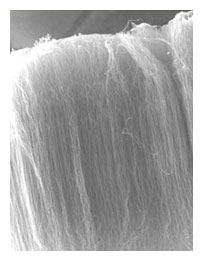AKRON, Ohio, Aug. 19 — The interest of University of Akron (UA) polymer researchers in the powerful surface sticking power of geckos soon could lead to advances in adhesives used in microelectronics, information technology, robotics and space applications.
The leopard gecko (eublepharis macularius) is one of nature's own nanotechnologists. Thanks to nanoscale fibers in the soles of their feet, these colorful lizards can easily walk up walls, or even hang from the ceiling by one toe. Photo: Gene Jenkins, Montezuma's Reptiles
Renowned for their ability to walk up walls like miniature Spider-Men -- or even to hang from the ceiling by one toe -- the colorful lizards of the gecko family owe their wall-crawling prowess to their remarkable footpads. Each five-toed foot is covered with microscopic elastic hairs called setae, which are themselves split at the ends to form a forest of nanoscale fibers known as spatulas. So when a gecko steps on almost anything, these nanohairs make such extremely close contact with the surface that they form intermolecular bonds, thus holding the foot in place.
The UA researchers are part of a team using a four-year, $400,000 grant from the National Science Foundation to develop synthetic hairs from carbon nanotubes that have adhesion forces 200 times higher than those observed with gecko foot-hairs. The team includes Ali Dhinojwala, UA associate professor of polymer science; UA polymer graduate student Betul Yurdumakan, and Nachiket Raravikar and professor Pulickel Ajayan from Rensselaer Polytechnic Institute in Troy, NY. The results of their work, titled "Synthetic Gecko Foot-Hairs from Multiwalled Carbon Nanotubes," were recently published in the journal Chemical Communications.
This scanning electron microscope image shows a side view of the artificial gecko foot at an early stage of preparation. Each of these densely packed fibers is actually a multiwalled carbon nanotube that has been grown on a polished silicon surface (below the frame) by standard techniques. Photo: Betul Yurdumakan, UA/Nachiket Raravikar, RPI.
"We already have strong adhesives that can support large forces, and we have weak adhesives such as sticky notes that can be used many times but are not strong enough to support large forces," Dhinojwala said." It will be a challenge to figure out how to design an adhesive that can provide a strong attachment to support a large force but at the same time have the capability of detaching itself from the surface with ease."
For more information, visit: www.nsf.gov